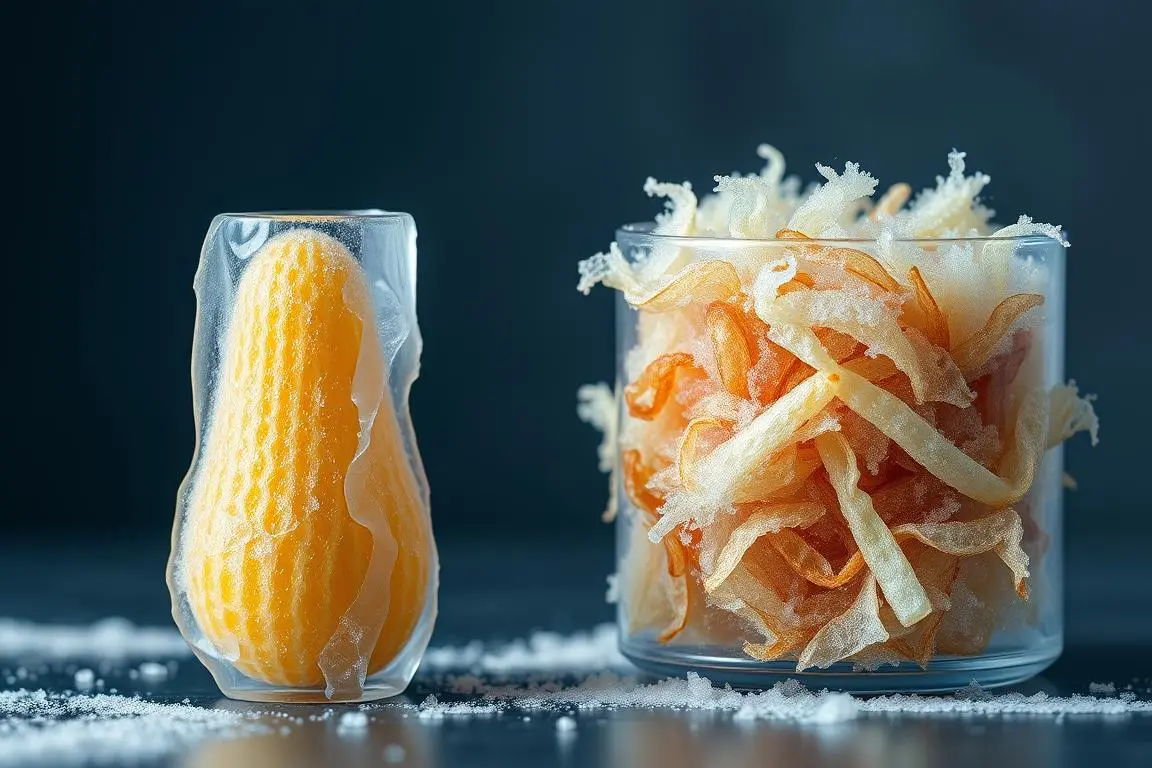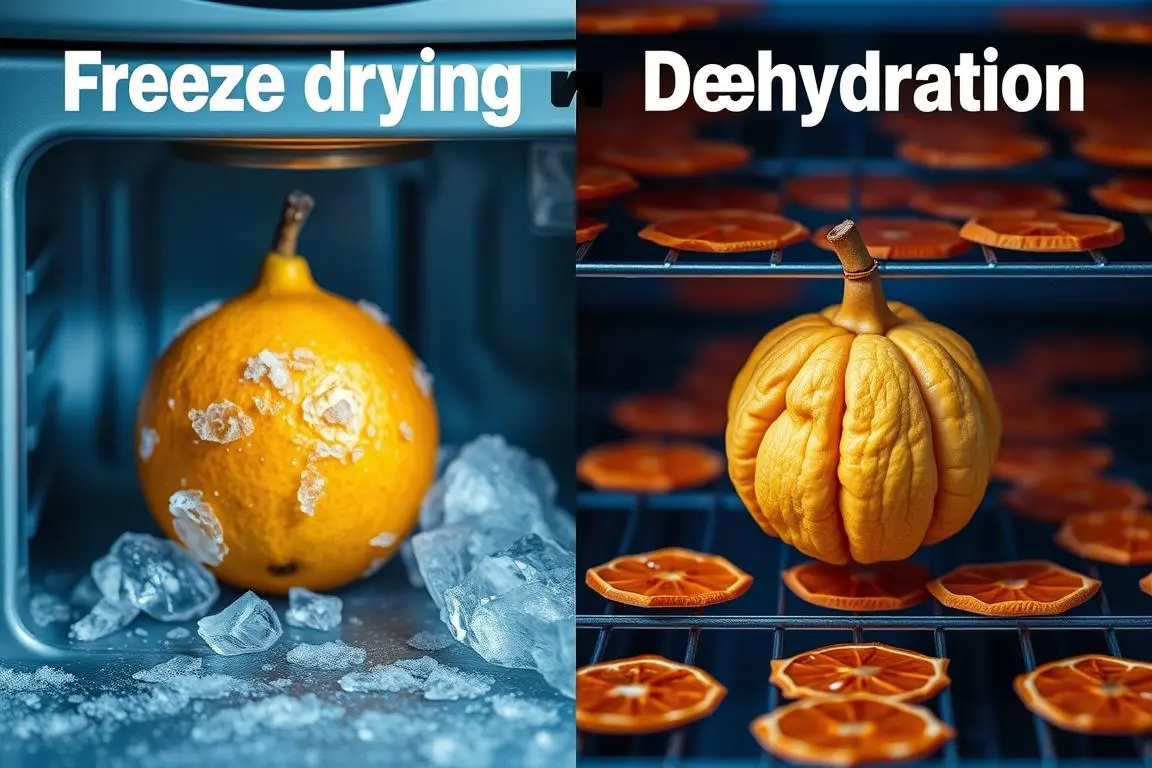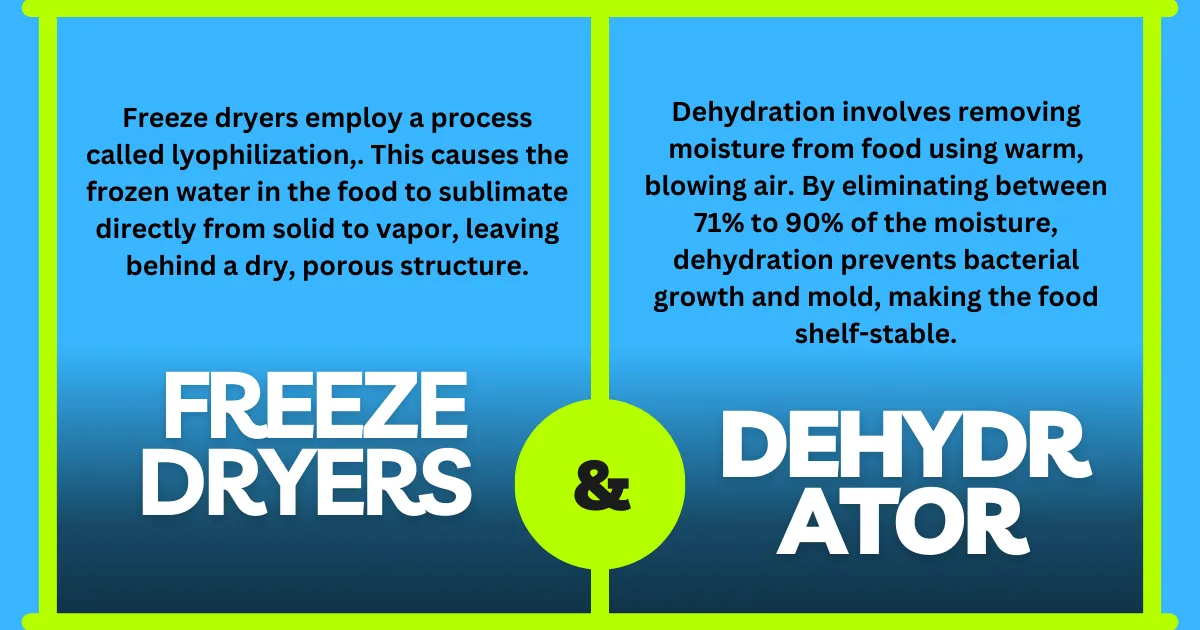Are freeze dryers and dehydrators the same? When it comes to food preservation methods, freeze dryers and dehydrators often come into the spotlight. Both are utilized to extend the shelf life of various food items, but are they really the same? Let’s delve into the intricacies of freeze dryers and dehydrators to uncover their similarities and differences and determine which one might be the better choice for your needs.
Freeze dryers and dehydrators are both appliances designed to remove moisture from food items, thereby preventing spoilage and preserving their quality. However, their underlying mechanisms and processes are distinct, leading to differences in the final product
Freeze Dryers vs. Dehydrators: What’s the Difference?
The global market for freeze-dried food is set to hit $66.23 billion by 2027. This shows how popular freeze drying is becoming, even more so than traditional dehydration. But what makes these methods different, and which one is best for you?
We’ll look into the key differences between freeze dryers and dehydrators. We’ll cover the science behind each, their effects on food quality and how long it lasts, and the pros and cons of using them at home or on a large scale. By the end, you’ll know which method is best for keeping your favorite foods fresh.

Key Takeaways
- Freeze drying and dehydration are two distinct food preservation methods with unique processes and outcomes.
- Freeze drying removes moisture through sublimation, while dehydration uses heat to evaporate water from food.
- Freeze-dried foods generally retain more nutrients and have a longer shelf life compared to dehydrated foods.
- Home freezer dryers offer greater control and customization, while commercial dehydrators are better suited for large-scale food production.
- The choice between freeze drying and dehydration depends on your specific preservation needs, budget, and personal preferences.
.
Differences in Process
How Freeze-Drying Works
Freeze dryers employ a process called lyophilization, which involves freezing the food at extremely low temperatures and then subjecting it to a vacuum environment. This causes the frozen water in the food to sublimate directly from solid to vapor, leaving behind a dry, porous structure.
- Mechanism: Freeze-drying uses extremely cold temperatures (around -40°F) and a vacuum chamber. The frozen food is placed in this chamber, where the pressure is lowered, causing the ice to sublimate.
- Process: The food is first frozen solid, then exposed to a vacuum. The temperature is alternately raised and lowered to facilitate the sublimation process, removing about 99% of the moisture content.
- Duration: The freeze-drying process is more time-consuming, typically taking 24 to 48 hours to complete.
Benefits of Freeze-Drying
- Nutrient Retention: Freeze-drying preserves the nutritional content of the food much better than dehydrating, maintaining nearly all the original vitamins and minerals.
- Texture: Freeze-dried foods retain their original shape and texture, making them more palatable when rehydrated.
- Shelf Life: Freeze-dried foods can last up to 25 years if stored properly, making them ideal for long-term storage.
Limitations of Freeze-Drying
- Cost: Freeze-drying units are significantly more expensive than dehydrators, often putting them out of reach for budget-conscious consumers.
- Complexity: Operating a freezer is more complex and requires careful monitoring and maintenance.
- Equipment Size: Freeze-dryers are typically larger and require more storage space than dehydrators.
How Dehydrators Work
Dehydrators, on the other hand, utilize heat and airflow to remove moisture from food items. By circulating warm air around the food, dehydrators gradually evaporate the water content, resulting in a shriveled and preserved product.
Dehydration involves removing moisture from food using warm, blowing air. By eliminating between 71% and 90% of the moisture, dehydration prevents bacterial growth and mold, making the food shelf-stable.
- Mechanism: Dehydration typically employs a dehydrator, which uses heat and air circulation to gradually reduce the moisture content of food. This can also be achieved using a low-temperature oven or simply by utilizing the natural warmth of a sunny day.
- Process: The food is sliced into thin pieces and spread out on the dehydrator trays. Warm air circulates around the food, steadily drawing out moisture.
- Duration: Depending on the type and thickness of the food, dehydration can take anywhere from a few hours to a couple of days.
Benefits of Dehydrating
- Ease of Use: Dehydrators are relatively simple to operate and require minimal maintenance.
- Cost-Effective: Basic dehydrators are affordable, making them accessible for most budgets.
- Shelf Life: Properly dehydrated foods can last about a year if stored in airtight containers away from light and moisture.
Dehydration Techniques
On the other hand, dehydration techniques use heat and air flow to dry out the food. This method is simpler and cheaper than freeze drying but might lose some flavor and nutrients. Dehydrated foods are used in snacks, camping meals, and emergency food packs.
It’s important to know the differences between these two moisture removal methods for preserving food. Whether you’re cooking at home, preparing for the wilderness, or making food for a business, understanding freeze drying and dehydration can guide your choices. It ensures the best results for your freeze-dried foods.

Are freeze dryers and dehydrators the same?
Many people ask if freeze dryers and dehydrators are the same. They both remove moisture from food, but they work in different ways and produce different results.
Freeze dryers use a method called sublimation to dry food. First, they freeze the food. Then, they reduce the pressure around it. This makes the ice turn directly into vapor without becoming liquid. The result is a light, porous, and long-lasting product that tastes and is nutritious like the original.
Dehydrators, on the other hand, use heat and air flow to dry food. This makes a chewier, denser food that doesn’t last as long as freeze-dried items. It also changes the taste and can reduce the food’s nutritional value.
| Freeze Dryers | Dehydrators |
|---|---|
| Use sublimation to remove water | Use heat and airflow to remove moisture |
| Produce a lightweight, porous, and shelf-stable product | Create chewier, denser, and less shelf-stable food |
| Retain more of the original flavor and nutritional content | May lose more nutritional value during the drying process |
Comparison Table: Freeze-Dryers vs. Dehydrators
| Aspect | Freeze-Dryers | Dehydrators |
|---|---|---|
| Nutritional Content | Preserves nearly all nutrients due to the low-temperature process. | Some nutrients are lost, especially heat-sensitive vitamins, due to warm air circulation. |
| Shelf Life | Up to 25 years when stored properly in airtight containers. | Typically, up to 1 year, depending on storage conditions and the moisture content removed. |
| Texture | Maintains its original shape and texture and rehydrates well. | Becomes chewy or leathery; significant texture change. |
| Taste | Retains original flavor, making it more palatable. | Flavor can concentrate, leading to a more intense, sometimes altered taste. |
| Process Duration | 24 to 48 hours, depending on food type and thickness. | A few hours to a couple of days, depending on food type and thickness. |
| Cost | High initial investment; home units can be expensive. | Generally affordable, basic models are budget-friendly. |
| Ease of Use | More complex and requires careful monitoring and maintenance. | Simple to operate; minimal maintenance needed. |
| Storage Space | Larger units require more storage space. | Typically, it is more compact and easier to store. |
| Energy Consumption | Higher energy use is due to the freezing and vacuum processes. | Lower energy use, primarily for heating elements. |
| Suitability | Ideal for long-term storage, emergency preparedness, and preserving nutrient-dense foods. | It is best for short-term storage, everyday snacks, and preserving seasonal produce. |
| Example | Freeze-dried strawberries retain more vitamin C and last for decades. | Dehydrated strawberries have a chewy texture and last about a year. |
Equipment and Mechanisms of freeze dryers and dehydrators
Components of Freeze Dryers
Freeze dryers consist of a vacuum chamber, freezing plates, a condenser, and a vacuum pump. The food is placed on trays within the vacuum chamber, where it undergoes the freeze-drying process.
Components of Dehydrators
Dehydrators typically feature trays or racks for placing the food, along with heating elements and fans for circulating air. The temperature and airflow settings can be adjusted based on the type of food being dehydrated.
Applications and Uses of Freezers and Dehydrators
Common Applications of Freeze Dryers
Freeze dryers are commonly used for preserving fruits, vegetables, meats, and even entire meals. They are favored for their ability to retain the original shape, color, and nutritional content of the food.
Common Uses of Dehydrators
Dehydrators are popular for making jerky, fruit leather, dried herbs, and snacks like banana chips. While they may alter the texture and color of the food slightly, they are still effective at preserving flavor and nutrients.
Nutritional Value Retention of Freezers and Dehydrators
Preservation of Nutrients in Freeze-Dried Foods
Freeze drying is known for preserving the nutritional integrity of foods, including vitamins, minerals, and antioxidants. The low temperatures involved help minimize nutrient degradation.
Preservation of Nutrients in Dehydrated Foods
Dehydrating foods may lead to some loss of heat-sensitive nutrients like vitamin C and certain enzymes. However, many nutrients remain intact, making dehydrated foods still nutritious.
Texture and Taste of freeze dryers and dehydrators
Texture of Freeze-Dried Foods
Freeze-dried foods typically have a light and crispy texture, almost retaining the original texture of fresh foods. This makes them popular for snacks and backpacking meals.
Texture of Dehydrated Foods
Dehydrated foods tend to be chewy or leathery in texture as they lose more moisture during the drying process. However, this texture can also be appealing in certain applications.
Storage and shelf life of freeze dryers and dehydrators
Shelf Life of Freeze-Dried Products
Freeze-dried products have an impressively long shelf life, often lasting for years when stored properly in sealed containers. Their low moisture content inhibits microbial growth and oxidation.
Shelf Life of Dehydrated Products
Dehydrated products also boast a decent shelf life, although not as long as freeze-dried products. Proper packaging and storage conditions are essential to prevent moisture absorption and spoilage.
Cost Considerations of Freezers and Dehydrators
Initial Investment for Freeze Dryers
Freeze dryers tend to be more expensive upfront due to their complex machinery and technology. However, their long-term cost-effectiveness can outweigh the initial investment for commercial or frequent use.
Initial Investment for Dehydrators
Dehydrators are more accessible to a larger variety of customers due to their relatively lower cost compared to freeze dryers. They are an economical option for home food preservation enthusiasts.
Environmental Impact
Energy Consumption of Freeze Dryers
Freeze dryers consume more energy compared to dehydrators, especially during the freezing and sublimation phases. However, their efficiency in preserving food and minimizing waste can offset their environmental footprint.
Energy Consumption of Dehydrators
Dehydrators typically consume less energy than freeze dryers, as they rely primarily on heat and airflow. However, prolonged drying times may still contribute to energy consumption, especially with larger batches.
Practicality and convenience
Ease of Use for Freeze Dryers
Freeze dryers require minimal hands-on involvement once the food is loaded into the chamber. However, the process of freezing and drying can take several hours or even days, depending on the food and batch size.
Ease of Use for Dehydrators
Dehydrators are straightforward to use, with adjustable settings for temperature and drying time. Users can easily monitor the progress of the dehydration process and adjust as needed.
Final Verdict: Which is Better?
In conclusion, freeze dryers and dehydrators each have their own set of advantages and limitations. The choice between the two ultimately depends on factors such as budget, intended use, and desired outcomes.
Conclusion of freeze dryers and dehydrators
While freeze dryers and dehydrators serve the common purpose of preserving food, they operate on distinct principles and yield different results. Understanding the nuances between these methods can help consumers make informed decisions based on their specific needs and preferences.
FAQs (Frequently Asked Questions) Are freeze dryers and dehydrators the same?
Can I use a dehydrator instead of a freezer for long-term food storage?
While dehydrators can extend the shelf life of foods, freeze dryers are more effective for long-term storage due to their ability to retain nutrients and texture over extended periods.
Are freeze-dried foods more expensive than dehydrated foods?
Freeze-dried foods tend to be more expensive due to the specialized equipment and processes involved. However, they offer superior quality and nutritional value compared to dehydrated foods.
Can I use a dehydrator to make freeze-dried foods?
No, the processes of freeze drying and dehydration are fundamentally different. Attempting to replicate freeze drying with a dehydrator will not yield the same results in terms of texture and quality.
Which foods are ideal candidates for freeze-drying?
Foods with high water content, such as fruits, vegetables, and cooked meats, are ideal candidates for freeze-drying. This method preserves their natural flavors and nutrients effectively.
